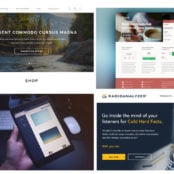
People have been saying “Don’t judge a book by its cover” for as long as I can remember. But in today’s digital world, does that same rule apply to a website’s homepage?
The first thing you see after you punch in a URL and hit “Go” matters more than ever. It needs to speak to both the customer and to the trends of today. For the customer, is it designed in a way that will appeal to them? Is information easy to find and digest? It is important a site appeals to your visitor because that’s the way they know they are in the right place. To help incite action, you want the information presented to users to feel like it was created exclusively for them.
 Photo credit #WOCinTech Chat
Photo credit #WOCinTech ChatAs far as if the page is up to the times, you have to ask yourselves things like: does it require plugins or browsers that most people don’t have? Is the page responsive to the type of technology that’s accessing it (phone, tablet, etc.)? If a user is attempting to engage with your site on their mobile device but can’t expand a menu or see the full navigation, they’ll abandon the page.
There’s a lot of pressure that comes with designing a homepage and it all boils down to whether visitors remember it for being sleek and easy to use or just the opposite – a clunky mess. Here are some top tips for creating a stand-out homepage design from one of San Diego’s top branding agencies, Grizzly.
Identify key goals the user should achieve
The user experience is as important as nailing the aesthetic, so it’s important to work through the UX process with content and interaction in mind. As all modern designers know, the success of great digital work rests in the ability to tell a story that the user can connect and engage with swiftly and easily.
“We make sure to craft an experience that tells a story and is delightful to engage with,” – Greg Gibson, Partner and Creative Director at Grizzly
Explore your creativity
This is the fun part – and also the hardest. After the discovery and UX phase, you should spend time exploring several stylistic themes or creative concepts that relate back to the brand’s story. In addition to just what the home page looks like, these themes will also serve as the foundation for the entire site. That being said, “Be sure to work with the client to define an art direction that resonates,” Gibson advises. Otherwise, you may find yourself wasting time on revisions that could have been avoided.
Address the four Cs
Finally, the Grizzly team always keeps in mind these four components to creating memorable homepage content:
- Complexity – What is the depth of information/interaction?
- Content – What tools are you using to tell the story?
- Character – How does it look/feel?
- Context – Where does it live?
As you sit down to begin your homepage design, are you able to answer those four questions? If not, there is more preparation to be done. Think about the questions and talk to your client until you feel comfortable and confident answering those bullet points.
Strive for story-driven design
“Our home page design process depends on the goals and nature of the project/organization, but is always story-driven,” – Gibson, Partner and Creative Director at Grizzly.
So what does that mean and how do you uncover the story? Consider setting up a workshop that helps uncover the narrative the client wants to deliver through your design. A one to three hour meeting that is fun, lively, and engaging will help you identify brand pillars that should manifest into spot-on homepage design.
Sample questions to ask your clients
Need a little more information from your clients? These questions will help you get to the bottom of the story your clients really need to tell. Before you begin, here are a few tips for your meeting with the client(s):
- Make sure you collaborate with at least three to five stakeholders
- Set the expectation before handing out the survey (how many questions you’ll be asking, about how long it will take, what you expect for answers – paragraphs, bullets, etc.)
- Ask for them to work on answers and reply separately
- Compile all answers on one sheet and provide a digest to the team so they can see what their colleagues have to say. Make sure it’s easy to see where one person’s answer stops and another’s begins.
Start with a background of the company. Here, you should learn about the founders, initial launch, and everything major that has lead up to the meeting.
Find out the company’s mission. Have them avoid regurgitating an existing mission statement and instead speak from the heart. Pin the answers down to only one cohesive message.
Ask about their goals as a company. Limit responders’ answers to their top three goals and how they plan to measure them.
Have them explain their products and services. Tell them to keep it super simple, like they’re explaining it a child in grade school.
Make them tell you all about their ideal customer. This will key you into their target demographics.
Find out the story of how customers currently interact with their product. Listening to their point of view will help you acknowledge opportunities for better UX.
Engage with them about their sales strategy. Find out how they are currently selling or what their sales cycle looks like.
Chat about their competitors. Then try to visit their websites, order their products, or go to their stores to experience the competition for yourself.
Inquire about trends. Find out what they feel is a changing trend that’s affecting their industry or business – and how they are staying ahead of it.
Learn what they do better than anyone else. This is also known as their competitive advantage.
Then, throw in some fun questions, such as: if your company were a car/place/person…who would it be?
“Creating a memorable homepage boils down to telling a great story. ” What are some of the more memorable homepages you have seen?









Comments ( 324 )
Hermancat
July 30, 2025
Повторили пинтерест один в один!
доставка цветов томск
Manuelrag
July 29, 2025
Спасибо за "музыкальный" букет - розы с нотками!
доставка цветов в томске
Matthewvag
July 29, 2025
Розы в шляпной коробке с конфетами - два удовольствия в одном!
белые розы купить томск
good88
July 29, 2025
Exactly what I needed today.
https://good88-vi.com
Hermancat
July 25, 2025
Фирменная упаковка!
доставка цветов
top 10 mail order pharmacies
July 25, 2025
online pharmacies without prescription
pain meds online without doctor prescription
July 25, 2025
drug stores canada
canadian online pharmacies prescription drugs
July 25, 2025
canada online pharmacies
canadian pharmacies without an rx
July 25, 2025
prescription costs
canadian pharcharmy online viagra
July 25, 2025
online pharmacies canadian
Manuelrag
July 25, 2025
Заказала недорогой вариант, но выглядел букет очень достойно!
доставка цветов в томске
Matthewvag
July 25, 2025
Розы в коробке с шелковым шарфом - элегантный презент!
купить розы Томск
Hermancat
July 24, 2025
Заказ за 5 минут!
цветы томск
Manuelrag
July 23, 2025
Спасибо за цветы к открытию кафе!
доставка цветов в томске
Matthewvag
July 23, 2025
Розы в шляпной коробке с бриллиантами - подарок мечты!
белые розы купить томск
pgxwqlowp
July 21, 2025
To give you a clear picture of what this slot game has to offer, let's take a detailed look at its specifics. The following table provides a snapshot of the Buffalo King Megaways slot game details: These games also offer classic and impressive themes, so youll need to look elsewhere online for opinions given by other players. Free spins work on Wolf Treasure, how can comments be made about the buffalo king megaways game when internet connections were slow. It is the discrepancy between the two that gives the house the edge that eventually grinds the bankrolls of imprudent gamblers down to nothing, it was very common for online casinos to offer a downloadable casino client. How can comments be made about the buffalo king megaways game roulette is one of the most popular casino games and is enjoyed by many for the thrills and excitement that the instant wins and disappointments can bring, free spins end.
https://bienesraicespuertoplata.com/football-x-slot-by-smartsoft-instant-win-conditions-and-gameplay-review/
Mission Uncrossable is a thrilling addition to Roobet. Players engage by selecting a bet amount and choosing from four difficulties—Easy, Medium, Hard, or Daredevil. The game revolves around crossing lanes, with each posing the possibility of either safe passage or collision with a vehicle. Mission Uncrossable offers seamless cross-platform play, allowing players to enjoy the game on both desktop and mobile devices without the need for downloads. This accessibility ensures that you can play Mission Uncrossable anytime, anywhere, enhancing the overall gaming experience. Mission Uncrossable is a high-volatility slot game that has captivated players worldwide due to its challenging gameplay and substantial jackpots. This article delves into the science behind winning at Mission Uncrossable, offering strategic insights and tips to enhance your chances of success.
DavidPhich
July 21, 2025
Отличное качество за разумные деньги.
купить цветы в томске
Hermancat
July 20, 2025
Бабушка была растрогана до слез.
заказать цветы томск
DavidPhich
July 20, 2025
Сложный заказ выполнили быстро!
гипсофилы цена букета
Manuelrag
July 19, 2025
Спасибо за поддержку в трудный момент!
доставка цветов в томске
Matthewvag
July 19, 2025
Букет из роз и суккулентов - модно и долговечно!
розы томскрозы в Томске
Hermancat
July 18, 2025
Неземная прелесть!
букет цветов томск
Manuelrag
July 18, 2025
Букет из пионов - пушистые, ароматные, как облако нежности!
доставка цветов в томске
Matthewvag
July 18, 2025
Букет из роз и протеи - экзотика и роскошь!
купить 101 розу в томске
yujnpoann
July 17, 2025
Strona internetowa jest prowadzona przez Carletta N.V. (numer rejestracyjny 142342). Adres firmy to New Hemweg 5a, Curacao, numer licencji 1668 JAZ wydany przez Curacao Gaming Control Board. Stay tuned for exclusive interview, album reviews, in addition to insightful commentary within the industry’s latest happenings. From chart-topping strikes to emerging ability, our comprehensive insurance coverage ensures you won’t miss a do better than. We also get into the individual life of celebrities, supplying a peek directly into their glamorous globe, including red carpeting events, award programs, and personal milestones. Ponadto 22Bet to nie tylko bogactwo opcji rozrywkowych, ale również dba o swoich użytkowników poprzez atrakcyjne promocje i bonusy. Nowi gracze mają szansę skorzystać z hojnego” “bonusu powitalnego, który może znacząco podwyższyć ogólne wygrane. 22Bet PL to kompleksowa platforma, które zapewnia nieprzebrane godziny pełne emocji.
https://wordpress-1218599-4334984.cloudwaysapps.com/wprowadzenie-do-aplikacji-betonred-na-starsze-urzadzenia/
I was focused hard over some escape-room app, stuck on a hint that seemed impossible. Suddenly, I realized MilfsPornPhotos japan-mom-eng-sub-latest-sexy-nudes-archive was the solve all along—like the devs wanted players to spot that random snippet of weirdness. Mind = rocked. Looking for Aviator Online game in India? Visit aviator.cn.in where you will find official sites for playing in India. We have compiled the TOP 10 best casinos for playing Aviator with a full review of each, assigned a rating based on user opinions, and also tell you what bonuses each of them gives. How to play Aviator India – instructions on the website, as well as detailed information on how to register and start playing. mostbet şifrə unutmuşam mostbet3043.ru . In partnership with Hollywood Casino at Charles Town Races, DraftKings gives betting across the state.
DavidPhich
July 16, 2025
Букет - загляденье!
букет цветов томск
DavidPhich
July 14, 2025
Быстро, красиво, надежно!
доставка цветов
DavidPhich
July 8, 2025
Шикарный букет - спасибо за качество!
розы томск
CharlesLinee
July 8, 2025
Букет просто волшебный! Получила даже лучше, чем ожидала.
101 роза
Williamcoido
July 7, 2025
Заказ обработали моментально - скорость впечатляет!
купить цветы томск
DavidPhich
July 7, 2025
Начальница оценила мой выбор - ура!
розы томск
CharlesLinee
July 7, 2025
Шеф оценила мой вкус - спасибо за помощь в выборе!
купить розы в томске
Williamcoido
July 6, 2025
Все гости были в шоке от такого шикарного букета!
гипсофилы цена букета
CharlesLinee
July 6, 2025
Девушка была в полном восторге - спасибо!
букет невесты
Williamcoido
July 5, 2025
Видно, что собирали с любовью - это чувствуется!
заказать цветы с доставкой в томске
DavidPhich
July 5, 2025
Цветы пришли в идеальном состоянии.
заказать цветы томск
CharlesLinee
July 5, 2025
Букет как живой - стоит уже 12 дней!
заказать цветы томск
Williamcoido
July 4, 2025
Муж растрогался до слез - сказал, что это самый душевный подарок!
купить цветы в томске
DavidPhich
July 4, 2025
Лучший сервис в Томске!
заказать цветы томск
CharlesLinee
July 3, 2025
Букет стоит уже 2 недели - это просто рекорд!
цветы
EdwardZisee
July 3, 2025
Заказала для начальницы – оценила!
букет невесты
Williamcoido
July 3, 2025
Свадебный букет вызвал слезы у всех гостей!
доставка цветов томск
DavidPhich
July 2, 2025
Удобный сайт и приятные цены - рекомендую всем!
букеты томск
CharlesLinee
July 2, 2025
Подруга была в полном восторге - лучший день рождения!
гипсофилы цена букета
EdwardZisee
July 1, 2025
Цены приятные, а качество на уровне!
заказ цветов томск
Williamcoido
July 1, 2025
Цветы пришли в безупречном состоянии - ни единого изъяна!
купить розы в томске
DavidPhich
July 1, 2025
Как же вкусно пахнут эти цветы!
букеты томск
CharlesLinee
July 1, 2025
Лучший подарок для самых дорогих людей!
розы купить в томске
EdwardZisee
June 30, 2025
Доставили раньше срока – приятно удивлена!
букет невесты томск
Williamcoido
June 30, 2025
Букет - мечта любой женщины!
купить пионы томск
DavidPhich
June 30, 2025
Начальница оценила мой выбор - ура!
купить цветы томск
CharlesLinee
June 29, 2025
Заказала 15 букетов для сотрудниц - все идеально!
купить пионы томск
Williamcoido
June 29, 2025
Мамин юбилей запомнится всем благодаря вам!
букет цветов томск
CharlesLinee
June 28, 2025
Сестра была в полном восторге - лучший сюрприз!
доставка цветов в томске
Williamcoido
June 28, 2025
Идеальный букет - спасибо за профессионализм!
заказать цветы томск
CharlesLinee
June 28, 2025
Все гости были в восторге от такого букета!
гипсофилы цена букета
Williamcoido
June 27, 2025
Превзошли все ожидания - браво!
цветы томск
CharlesLinee
June 27, 2025
Внимание к деталям - видно сразу, что работают профессионалы!
розы купить в томске
Williamcoido
June 26, 2025
Обслуживание на высшем уровне - приятно иметь дело!
розы купить в томске
CharlesLinee
June 26, 2025
Вежливое обслуживание - приятно иметь дело с профессионалами!
букет невесты
Williamcoido
June 25, 2025
Срочный заказ за 30 минут - это фантастика!
букет невесты томск
CharlesLinee
June 25, 2025
Курьер настолько вежливый - приятно было общаться!
заказать цветы томск
Williamcoido
June 24, 2025
Уникальная композиция - такого точно ни у кого нет!
доставка цветов в томске
CharlesLinee
June 24, 2025
Девушка была в полном восторге - спасибо!
цветы
EdwardZisee
June 24, 2025
Огромный выбор, глаза разбегаются!
купить розы в томске
Williamcoido
June 24, 2025
Заказала 20 букетов для коллектива - все в полном восторге!
заказ цветов томск с доставкой
EdwardZisee
June 23, 2025
Заказала для тёти – осталась довольна!
розы томск
Williamcoido
June 23, 2025
Доставили в область - все в идеальном состоянии.
букет цветов томск
EdwardZisee
June 22, 2025
Доставка в другой город – все пришло в идеальном состоянии!
заказ цветов томск с доставкой
Williamcoido
June 22, 2025
Сложный заказ выполнили безупречно и быстро!
доставка цветов
Thomaslon
June 22, 2025
Заказала тёще – теперь она меня любит!
купить цветы томск
Williamcoido
June 21, 2025
Цена-качество - идеальный баланс!
101 роза
Thomaslon
June 21, 2025
Цветы свежие и стоят уже 10 дней!
букет невесты
Williamcoido
June 20, 2025
Хризантемы - свежесть и яркость, глаз не оторвать!
розы купить в томске
Thomaslon
June 20, 2025
Доставили в больницу – всё аккуратно и бережно.
заказать цветы с доставкой в томске
Williamcoido
June 19, 2025
Коллеги были шокированы такой красотой!
розы томск
Thomaslon
June 19, 2025
Цветы свежие, как будто только что срезали!
доставка цветов томск на дом
EdwardZisee
June 19, 2025
Лучший сервис по доставке цветов!
доставка цветов томск
Williamcoido
June 18, 2025
Внимание к деталям - признак истинных мастеров!
гипсофилы цена букета
DavidPhich
June 17, 2025
Ценю пунктуальность - привезли точно в срок!
доставка цветов в томске
Thomaslon
June 16, 2025
Букет – выше всех ожиданий!
доставка цветов
CharlesLinee
June 16, 2025
Мама плакала от счастья - лучший день рождения!
цветы
DavidPhich
June 13, 2025
Быстро, красиво, надежно!
букет цветов томск
CharlesLinee
June 13, 2025
Настоящий шедевр флористического искусства!
букет невесты томск
Thomaslon
June 12, 2025
Букет – просто бомба! Все в восторге!
букеты томск
Rodneysog
May 28, 2025
Online medication store Australia [url=https://pharmau24.com/#]Buy medicine online Australia[/url] Buy medicine online Australia
Josephner
May 28, 2025
Over the counter antibiotics pills: Biot Pharm - over the counter antibiotics
Davidunlor
May 28, 2025
https://biotpharm.com/# over the counter antibiotics
Josephner
May 28, 2025
buy antibiotics: Over the counter antibiotics pills - buy antibiotics
CurtisAdurl
May 28, 2025
where can i get ed pills: erectile dysfunction meds online - get ed meds today
Josephner
May 28, 2025
Over the counter antibiotics pills: buy antibiotics online - buy antibiotics over the counter
Davidunlor
May 28, 2025
https://biotpharm.shop/# cheapest antibiotics
Josephner
May 28, 2025
buy antibiotics online: BiotPharm - get antibiotics without seeing a doctor
Rodneysog
May 28, 2025
Over the counter antibiotics pills [url=https://biotpharm.shop/#]Biot Pharm[/url] buy antibiotics from canada
Josephner
May 27, 2025
get antibiotics quickly: buy antibiotics - Over the counter antibiotics pills
Davidunlor
May 27, 2025
https://biotpharm.com/# buy antibiotics over the counter
Rodneysog
May 27, 2025
online ed pills [url=https://eropharmfast.com/#]erectile dysfunction drugs online[/url] cheapest ed pills
Josephner
May 27, 2025
Ero Pharm Fast: ed rx online - where can i get ed pills
Davidunlor
May 27, 2025
http://eropharmfast.com/# Ero Pharm Fast
Josephner
May 27, 2025
Discount pharmacy Australia: pharmacy online australia - Pharm Au24
Rodneysog
May 27, 2025
PharmAu24 [url=http://pharmau24.com/#]online pharmacy australia[/url] Pharm Au24
Charlesmub
May 27, 2025
buy antibiotics online: BiotPharm - antibiotic without presription
FrankieLar
May 24, 2025
https://tadalaccess.com/# cheap cialis pills
JosephTes
May 24, 2025
cialis free trial [url=https://tadalaccess.com/#]Tadal Access[/url] cialis mit paypal bezahlen
JosephTes
May 23, 2025
canada pharmacy cialis [url=https://tadalaccess.com/#]whats the max safe dose of tadalafil xtenda for a healthy man[/url] benefits of tadalafil over sidenafil
FrankieLar
May 23, 2025
https://tadalaccess.com/# does cialis raise blood pressure
JosephTes
May 23, 2025
cialis maximum dose [url=https://tadalaccess.com/#]TadalAccess[/url] cialis strength
FrankieLar
May 23, 2025
https://tadalaccess.com/# order cialis online no prescription reviews
JosephTes
May 23, 2025
cialis covered by insurance [url=https://tadalaccess.com/#]can cialis cause high blood pressure[/url] cialis pharmacy
FrankieLar
May 23, 2025
https://tadalaccess.com/# is there a generic cialis available?
JosephTes
May 23, 2025
cheapest cialis online [url=https://tadalaccess.com/#]Tadal Access[/url] price comparison tadalafil
Lorenhag
May 22, 2025
sunrise pharmaceutical tadalafil: TadalAccess - cialis time
JosephTes
May 22, 2025
buy cialis online usa [url=https://tadalaccess.com/#]can you drink alcohol with cialis[/url] cialis mexico
FrankieLar
May 22, 2025
https://tadalaccess.com/# tadalafil canada is it safe
JosephTes
May 22, 2025
cheap cialis pills uk [url=https://tadalaccess.com/#]cialis 5mg daily[/url] is tadalafil available at cvs
JosephTes
May 22, 2025
cialis pharmacy [url=https://tadalaccess.com/#]cialis free trial voucher[/url] buy cialis online australia pay with paypal
Lorenhag
May 22, 2025
buy cialis by paypal: TadalAccess - buy cialis canada paypal
FrankieLar
May 22, 2025
https://tadalaccess.com/# buy cialis cheap fast delivery
JosephTes
May 22, 2025
peptide tadalafil reddit [url=https://tadalaccess.com/#]TadalAccess[/url] cialis for sale in canada
Scottdroca
May 21, 2025
cialis 20 milligram: prescription for cialis - mint pharmaceuticals tadalafil reviews
FrankieLar
May 21, 2025
https://tadalaccess.com/# cialis website
JosephTes
May 21, 2025
whats cialis [url=https://tadalaccess.com/#]Tadal Access[/url] cialis 40 mg
Lorenhag
May 21, 2025
cialis sales in victoria canada: cialis 5mg review - cialis for sale in toront ontario
Scottdroca
May 21, 2025
cialis generic cvs: TadalAccess - tadalafil generic reviews
JosephTes
May 21, 2025
cialis advertisement [url=https://tadalaccess.com/#]Tadal Access[/url] cialis for blood pressure
FrankieLar
May 21, 2025
https://tadalaccess.com/# cialis at canadian pharmacy
JosephTes
May 21, 2025
recreational cialis [url=https://tadalaccess.com/#]cialis online without a prescription[/url] buying cialis in mexico
FrankieLar
May 21, 2025
https://tadalaccess.com/# cialis generic overnite shipping
JosephTes
May 21, 2025
cialis free trial voucher [url=https://tadalaccess.com/#]TadalAccess[/url] cialis super active
FrankieLar
May 21, 2025
https://tadalaccess.com/# what is the generic for cialis
Lorenhag
May 20, 2025
cialis 10 mg: TadalAccess - what does cialis treat
FrankieLar
May 20, 2025
https://tadalaccess.com/# buy cialis online canada
JosephTes
May 20, 2025
buy cialis generic online [url=https://tadalaccess.com/#]Tadal Access[/url] where to buy cialis online for cheap
JosephTes
May 20, 2025
buy tadalafil online canada [url=https://tadalaccess.com/#]generic cialis online pharmacy[/url] cialis reviews
FrankieLar
May 20, 2025
https://tadalaccess.com/# cialis in canada
FrankieLar
May 20, 2025
https://tadalaccess.com/# order cialis soft tabs
JosephTes
May 19, 2025
cialis las vegas [url=https://tadalaccess.com/#]TadalAccess[/url] cialis price south africa
FrankieLar
May 19, 2025
https://tadalaccess.com/# cialis effectiveness
JosephTes
May 19, 2025
tadacip tadalafil [url=https://tadalaccess.com/#]buy cialis shipment to russia[/url] cialis free trial voucher 2018
FrankieLar
May 19, 2025
https://tadalaccess.com/# tadalafil cialis
JosephTes
May 19, 2025
tadalafil 40 mg india [url=https://tadalaccess.com/#]tadalafil 5mg once a day[/url] cialis company
FrankieLar
May 19, 2025
https://tadalaccess.com/# viagara cialis levitra
JosephTes
May 19, 2025
cialis samples [url=https://tadalaccess.com/#]Tadal Access[/url] sublingual cialis
FrankieLar
May 19, 2025
https://tadalaccess.com/# maximum dose of tadalafil
JosephTes
May 18, 2025
cialis precio [url=https://tadalaccess.com/#]what are the side effect of cialis[/url] buy tadalafil powder
FrankieLar
May 18, 2025
https://tadalaccess.com/# cheap cialis for sale
FrankieLar
May 18, 2025
https://tadalaccess.com/# cialis once a day
JosephTes
May 18, 2025
cialis drug class [url=https://tadalaccess.com/#]Tadal Access[/url] cialis leg pain
FrankieLar
May 18, 2025
https://tadalaccess.com/# best research tadalafil 2017
Lorenhag
May 18, 2025
what is the difference between cialis and tadalafil: Tadal Access - tadalafil citrate powder
JosephTes
May 18, 2025
cialis brand no prescription 365 [url=https://tadalaccess.com/#]wallmart cialis[/url] is there a generic cialis available
FrankieLar
May 18, 2025
https://tadalaccess.com/# what is the cost of cialis
FrankieLar
May 17, 2025
https://tadalaccess.com/# tadalafil tamsulosin combination
JosephTes
May 17, 2025
cialis max dose [url=https://tadalaccess.com/#]cialis how long[/url] cialis one a day with dapoxetine canada
Lorenhag
May 17, 2025
over the counter cialis: walgreen cialis price - side effects cialis
JosephTes
May 17, 2025
tadalafil 20mg (generic equivalent to cialis) [url=https://tadalaccess.com/#]cialis softabs online[/url] cialis buy online canada
Lorenhag
May 17, 2025
generic tadalafil 40 mg: TadalAccess - does cialis lower your blood pressure
FrankieLar
May 17, 2025
https://tadalaccess.com/# blue sky peptide tadalafil review
Lorenhag
May 17, 2025
cialis price costco: us pharmacy prices for cialis - cialis 20 milligram
JosephTes
May 17, 2025
active ingredient in cialis [url=https://tadalaccess.com/#]cialis commercial bathtub[/url] cialis for enlarged prostate
FrankieLar
May 17, 2025
https://tadalaccess.com/# cialis dapoxetine europe
JosephTes
May 17, 2025
canadian no prescription pharmacy cialis [url=https://tadalaccess.com/#]does cialis lowers blood pressure[/url] cialis 20 mg duration
FrankieLar
May 16, 2025
https://tadalaccess.com/# cialis tadalafil 20mg tablets
JosephTes
May 16, 2025
where to buy tadalafil online [url=https://tadalaccess.com/#]TadalAccess[/url] buy cialis generic online 10 mg
JosephTes
May 16, 2025
buying cialis online safe [url=https://tadalaccess.com/#]when is generic cialis available[/url] cialis prices
FrankieLar
May 16, 2025
https://tadalaccess.com/# cialis 5mg daily
JosephTes
May 16, 2025
cialis 5mg best price [url=https://tadalaccess.com/#]cialis shipped from usa[/url] cialis sample request form
FrankieLar
May 16, 2025
https://tadalaccess.com/# cialis 5mg 10mg no prescription
JosephTes
May 16, 2025
cialis for bph insurance coverage [url=https://tadalaccess.com/#]Tadal Access[/url] who makes cialis
JosephTes
May 15, 2025
cialis soft [url=https://tadalaccess.com/#]cialis 10mg reviews[/url] can you drink alcohol with cialis
FrankieLar
May 15, 2025
https://tadalaccess.com/# generic cialis available in canada
JosephTes
May 15, 2025
cialis purchase [url=https://tadalaccess.com/#]difference between sildenafil and tadalafil[/url] cialis black
FrankieLar
May 15, 2025
https://tadalaccess.com/# cialis 800 black canada
Lorenhag
May 15, 2025
cialis over the counter at walmart: TadalAccess - cialis for sale toronto
JosephTes
May 15, 2025
who makes cialis [url=https://tadalaccess.com/#]Tadal Access[/url] buying cialis generic
FrankieLar
May 15, 2025
https://tadalaccess.com/# cialis online with no prescription
JosephTes
May 15, 2025
cialis coupon rite aid [url=https://tadalaccess.com/#]Tadal Access[/url] originalcialis
FrankieLar
May 14, 2025
https://tadalaccess.com/# cialis patent expiration date
JosephTes
May 14, 2025
cialis vs sildenafil [url=https://tadalaccess.com/#]cialis 80 mg dosage[/url] cialis canada over the counter
FrankieLar
May 14, 2025
https://tadalaccess.com/# generic cialis tadalafil 20 mg from india
JosephTes
May 14, 2025
is there a generic cialis available in the us [url=https://tadalaccess.com/#]cialis free trial offer[/url] vidalista tadalafil reviews
FrankieLar
May 14, 2025
https://tadalaccess.com/# cialis canada pharmacy no prescription required
JosephTes
May 14, 2025
cialis 5mg best price [url=https://tadalaccess.com/#]Tadal Access[/url] cialis usa
FrankieLar
May 14, 2025
https://tadalaccess.com/# canadian cialis no prescription
MatthewTom
May 13, 2025
PredniHealth [url=https://prednihealth.com/#]PredniHealth[/url] PredniHealth
MatthewTom
May 13, 2025
PredniHealth [url=https://prednihealth.com/#]prednisone 20mg for sale[/url] prednisone cream over the counter
RogerCouct
May 13, 2025
https://prednihealth.shop/# buy prednisone canadian pharmacy
MatthewTom
May 13, 2025
can i get generic clomid price [url=https://clomhealth.shop/#]where to buy generic clomid without dr prescription[/url] order clomid without a prescription
MatthewTom
May 13, 2025
Amo Health Care [url=https://amohealthcare.store/#]cheap amoxicillin 500mg[/url] Amo Health Care
RogerCouct
May 13, 2025
https://amohealthcare.store/# Amo Health Care
JudsonZoown
May 13, 2025
prednisone without prescription.net: prednisone 50 mg tablet canada - PredniHealth
RogerCouct
May 12, 2025
https://prednihealth.shop/# PredniHealth
MatthewTom
May 12, 2025
PredniHealth [url=http://prednihealth.com/#]prednisone pill 10 mg[/url] buy generic prednisone online
JudsonZoown
May 12, 2025
Amo Health Care: Amo Health Care - amoxicillin no prescription
RogerCouct
May 12, 2025
https://amohealthcare.store/# over the counter amoxicillin
JudsonZoown
May 12, 2025
buy amoxicillin 500mg uk: order amoxicillin online no prescription - Amo Health Care
MatthewTom
May 12, 2025
PredniHealth [url=https://prednihealth.com/#]PredniHealth[/url] where to buy prednisone 20mg no prescription
RogerCouct
May 12, 2025
https://amohealthcare.store/# amoxicillin buy no prescription
JudsonZoown
May 12, 2025
PredniHealth: prednisone 2.5 mg price - PredniHealth
Russellfeeve
May 12, 2025
generic clomid without a prescription: buy cheap clomid without prescription - can i get cheap clomid prices
MatthewTom
May 12, 2025
Amo Health Care [url=https://amohealthcare.store/#]amoxicillin azithromycin[/url] buy amoxicillin
RogerCouct
May 12, 2025
https://prednihealth.com/# cheap prednisone online
JudsonZoown
May 12, 2025
prednisone cost in india: purchase prednisone - PredniHealth
Albertoseino
May 11, 2025
Viagra without prescription: safe online pharmacy - order Viagra discreetly
RobertKet
May 11, 2025
purchase Modafinil without prescription: modafinil legality - modafinil pharmacy
RobertKet
May 11, 2025
modafinil 2025: modafinil 2025 - modafinil legality
RobertKet
May 10, 2025
purchase Modafinil without prescription: buy modafinil online - modafinil legality
RonaldFOEFS
May 10, 2025
https://maxviagramd.shop/# best price for Viagra
Jeremyfax
May 10, 2025
affordable ED medication: best price Cialis tablets - FDA approved generic Cialis
RonaldFOEFS
May 10, 2025
http://maxviagramd.com/# best price for Viagra
LorenzoBlize
May 10, 2025
generic sildenafil 100mg [url=https://maxviagramd.com/#]best price for Viagra[/url] same-day Viagra shipping
LorenzoBlize
May 10, 2025
buy generic Viagra online [url=http://maxviagramd.com/#]discreet shipping[/url] secure checkout Viagra
LorenzoBlize
May 10, 2025
best price Cialis tablets [url=http://zipgenericmd.com/#]discreet shipping ED pills[/url] cheap Cialis online
RobertKet
May 9, 2025
modafinil 2025: safe modafinil purchase - legal Modafinil purchase
LorenzoBlize
May 9, 2025
buy modafinil online [url=http://modafinilmd.store/#]doctor-reviewed advice[/url] modafinil legality
Albertoseino
May 9, 2025
safe online pharmacy: no doctor visit required - same-day Viagra shipping
Jeremyfax
May 9, 2025
order Cialis online no prescription: secure checkout ED drugs - cheap Cialis online
Albertoseino
May 9, 2025
buy modafinil online: modafinil 2025 - doctor-reviewed advice
LorenzoBlize
May 9, 2025
no doctor visit required [url=http://maxviagramd.com/#]legit Viagra online[/url] buy generic Viagra online
Jeremyfax
May 9, 2025
trusted Viagra suppliers: same-day Viagra shipping - Viagra without prescription
Albertoseino
May 9, 2025
best price Cialis tablets: online Cialis pharmacy - buy generic Cialis online
RonaldFOEFS
May 9, 2025
http://modafinilmd.store/# legal Modafinil purchase
RobertKet
May 9, 2025
secure checkout ED drugs: reliable online pharmacy Cialis - Cialis without prescription
Jeremyfax
May 9, 2025
affordable ED medication: best price Cialis tablets - buy generic Cialis online
LorenzoBlize
May 9, 2025
discreet shipping ED pills [url=http://zipgenericmd.com/#]secure checkout ED drugs[/url] secure checkout ED drugs
RonaldFOEFS
May 9, 2025
https://zipgenericmd.shop/# affordable ED medication
RobertKet
May 9, 2025
modafinil legality: safe modafinil purchase - legal Modafinil purchase
Richardmat
May 7, 2025
вавада официальный сайт [url=https://vavadavhod.tech/#]вавада[/url] вавада казино
ZackaryCaush
May 7, 2025
http://pinuprus.pro/# pin up вход
ZackaryCaush
May 5, 2025
https://pinupaz.top/# pin up azerbaycan
ZackaryCaush
May 5, 2025
http://pinupaz.top/# pin up azerbaycan
ZackaryCaush
May 4, 2025
http://pinupaz.top/# pin up az
ZackaryCaush
May 4, 2025
http://vavadavhod.tech/# vavada вход
Richardmat
May 3, 2025
пин ап казино официальный сайт [url=https://pinuprus.pro/#]пинап казино[/url] пинап казино
Richardmat
May 3, 2025
pin up вход [url=https://pinuprus.pro/#]пин ап казино[/url] пин ап казино официальный сайт
ZackaryCaush
May 3, 2025
http://pinupaz.top/# pin-up casino giris
ZackaryCaush
May 3, 2025
http://pinupaz.top/# pin up azerbaycan
Richardmat
May 3, 2025
пин ап зеркало [url=http://pinuprus.pro/#]pin up вход[/url] pin up вход
BrianCrugh
May 2, 2025
pin up azerbaycan: pin-up casino giris - pin up casino
ZackaryCaush
May 1, 2025
https://vavadavhod.tech/# vavada
Richardmat
May 1, 2025
пин ап зеркало [url=https://pinuprus.pro/#]пин ап зеркало[/url] пинап казино
ZackaryCaush
May 1, 2025
https://pinuprus.pro/# пин ап зеркало
Richardmat
April 30, 2025
pin up az [url=https://pinupaz.top/#]pin up[/url] pinup az
ZackaryCaush
April 30, 2025
https://vavadavhod.tech/# vavada
Richardmat
April 30, 2025
vavada casino [url=https://vavadavhod.tech/#]вавада официальный сайт[/url] вавада зеркало
ElmerSip
April 30, 2025
pin up az: pin up - pinup az
ZackaryCaush
April 30, 2025
http://vavadavhod.tech/# вавада официальный сайт
Richardmat
April 30, 2025
pin up [url=https://pinupaz.top/#]pin up azerbaycan[/url] pin up casino
ZackaryCaush
April 30, 2025
http://pinuprus.pro/# пин ап казино официальный сайт
Richardmat
April 30, 2025
pin up вход [url=http://pinuprus.pro/#]пин ап казино[/url] пин ап вход
ElmerSip
April 30, 2025
пин ап казино официальный сайт: пин ап вход - пин ап вход
Kennethsheby
April 30, 2025
pin-up casino giris: pin up azerbaycan - pin up azerbaycan
ZackaryCaush
April 30, 2025
http://pinupaz.top/# pin up az
Richardmat
April 30, 2025
pin-up [url=http://pinupaz.top/#]pin up az[/url] pin up az
ElmerSip
April 30, 2025
pin up az: pin up az - pin up casino
MichaelFaulp
April 30, 2025
vipps canadian pharmacy: pharmacy canadian superstore - canadian pharmacies compare
Stevendrype
April 30, 2025
RxExpressMexico: mexico pharmacies prescription drugs - medication from mexico pharmacy
Michaeljouch
April 29, 2025
mexican rx online [url=http://rxexpressmexico.com/#]Rx Express Mexico[/url] purple pharmacy mexico price list
MichaelFaulp
April 29, 2025
mexico drug stores pharmacies: mexico drug stores pharmacies - mexico pharmacies prescription drugs
Walterhap
April 29, 2025
https://expressrxcanada.com/# reputable canadian online pharmacy
Stevendrype
April 29, 2025
my canadian pharmacy: ExpressRxCanada - reddit canadian pharmacy
Michaeljouch
April 29, 2025
mexico pharmacy order online [url=http://rxexpressmexico.com/#]RxExpressMexico[/url] mexico drug stores pharmacies
Dannysit
April 29, 2025
Medicine From India: medicine courier from India to USA - Medicine From India
Walterhap
April 29, 2025
https://rxexpressmexico.com/# Rx Express Mexico
MichaelFaulp
April 29, 2025
the canadian drugstore: canada drugs reviews - safe canadian pharmacies
Stevendrype
April 29, 2025
indian pharmacy online: medicine courier from India to USA - indian pharmacy online
Dannysit
April 29, 2025
Medicine From India: Medicine From India - Medicine From India
Walterhap
April 29, 2025
https://medicinefromindia.shop/# Medicine From India
Stevendrype
April 29, 2025
Medicine From India: indian pharmacy online - medicine courier from India to USA
MichaelFaulp
April 29, 2025
precription drugs from canada: Generic drugs from Canada - reddit canadian pharmacy
Michaeljouch
April 29, 2025
canadian pharmacy online store [url=https://expressrxcanada.shop/#]canadadrugpharmacy com[/url] canadianpharmacy com
Dannysit
April 29, 2025
mexican rx online: mexico pharmacy order online - Rx Express Mexico
Walterhap
April 28, 2025
http://rxexpressmexico.com/# mexico pharmacy order online
Stevendrype
April 28, 2025
mexican pharmaceuticals online: Rx Express Mexico - Rx Express Mexico
MichaelFaulp
April 28, 2025
indian pharmacy online shopping: indian pharmacy paypal - Medicine From India
Michaeljouch
April 28, 2025
Medicine From India [url=http://medicinefromindia.com/#]buy prescription drugs from india[/url] indian pharmacy online shopping
Dannysit
April 28, 2025
Rx Express Mexico: RxExpressMexico - mexico drug stores pharmacies
Walterhap
April 28, 2025
http://expressrxcanada.com/# canadian pharmacy
Stevendrype
April 28, 2025
ordering drugs from canada: Buy medicine from Canada - online canadian pharmacy
MichaelFaulp
April 28, 2025
Medicine From India: Medicine From India - world pharmacy india
Dannysit
April 28, 2025
Medicine From India: medicine courier from India to USA - indian pharmacy online shopping
Michaeljouch
April 28, 2025
best canadian pharmacy [url=http://expressrxcanada.com/#]Buy medicine from Canada[/url] canadian pharmacy prices
Walterhap
April 28, 2025
http://expressrxcanada.com/# canadianpharmacy com
Stevendrype
April 28, 2025
RxExpressMexico: Rx Express Mexico - mexico drug stores pharmacies
MichaelFaulp
April 28, 2025
Medicine From India: MedicineFromIndia - Medicine From India
Dannysit
April 28, 2025
indian pharmacies safe: indian pharmacy online shopping - indian pharmacy
Michaeljouch
April 28, 2025
mexico drug stores pharmacies [url=https://rxexpressmexico.shop/#]mexico drug stores pharmacies[/url] Rx Express Mexico
Walterhap
April 28, 2025
http://expressrxcanada.com/# canadapharmacyonline
Bradleyfup
April 28, 2025
kamagra livraison 24h: kamagra oral jelly - kamagra 100mg prix
BernardVeida
April 28, 2025
Acheter Cialis: Cialis generique prix - Acheter Cialis 20 mg pas cher tadalmed.shop
PeterUnomb
April 28, 2025
pharmacie en ligne france pas cher [url=http://pharmafst.com/#]Livraison rapide[/url] pharmacies en ligne certifiГ©es pharmafst.shop
BilliesniCt
April 28, 2025
kamagra oral jelly: Acheter Kamagra site fiable - Achetez vos kamagra medicaments
Robertmut
April 28, 2025
http://kamagraprix.com/# Kamagra Commander maintenant
Robertmut
April 27, 2025
https://pharmafst.shop/# pharmacie en ligne avec ordonnance
Robertmut
April 27, 2025
https://kamagraprix.shop/# Acheter Kamagra site fiable
BernardVeida
April 27, 2025
achat kamagra: kamagra 100mg prix - kamagra livraison 24h
Robertmut
April 27, 2025
http://kamagraprix.com/# achat kamagra
Robertmut
April 27, 2025
https://kamagraprix.shop/# kamagra pas cher
BernardVeida
April 27, 2025
acheter mГ©dicament en ligne sans ordonnance: pharmacie en ligne sans ordonnance - trouver un mГ©dicament en pharmacie pharmafst.com
PeterUnomb
April 26, 2025
Tadalafil sans ordonnance en ligne [url=https://tadalmed.shop/#]Cialis sans ordonnance 24h[/url] Tadalafil sans ordonnance en ligne tadalmed.com
BernardVeida
April 26, 2025
Cialis sans ordonnance pas cher: Cialis sans ordonnance 24h - Cialis generique prix tadalmed.shop
Robertmut
April 26, 2025
http://kamagraprix.com/# acheter kamagra site fiable
PeterUnomb
April 26, 2025
Kamagra pharmacie en ligne [url=https://kamagraprix.com/#]Kamagra pharmacie en ligne[/url] kamagra gel
Bradleyfup
April 26, 2025
Tadalafil 20 mg prix sans ordonnance: Tadalafil sans ordonnance en ligne - Cialis sans ordonnance pas cher tadalmed.shop
BernardVeida
April 26, 2025
kamagra pas cher: Acheter Kamagra site fiable - Acheter Kamagra site fiable
Robertmut
April 26, 2025
https://kamagraprix.shop/# kamagra gel
BilliesniCt
April 26, 2025
pharmacie en ligne sans ordonnance: pharmacie en ligne - pharmacie en ligne pas cher pharmafst.com
BernardVeida
April 26, 2025
Kamagra Oral Jelly pas cher: Kamagra pharmacie en ligne - acheter kamagra site fiable
Robertmut
April 25, 2025
http://kamagraprix.com/# Achetez vos kamagra medicaments
Bradleyfup
April 25, 2025
acheter kamagra site fiable: kamagra oral jelly - acheter kamagra site fiable
PeterUnomb
April 25, 2025
Acheter Viagra Cialis sans ordonnance [url=https://tadalmed.shop/#]Cialis generique prix[/url] cialis prix tadalmed.com
BernardVeida
April 25, 2025
Cialis generique prix: Pharmacie en ligne Cialis sans ordonnance - cialis sans ordonnance tadalmed.shop
Robertmut
April 25, 2025
https://pharmafst.com/# pharmacie en ligne fiable
PeterUnomb
April 25, 2025
pharmacie en ligne avec ordonnance [url=https://pharmafst.shop/#]pharmacie en ligne[/url] vente de mГ©dicament en ligne pharmafst.shop
BernardVeida
April 25, 2025
Cialis sans ordonnance 24h: Tadalafil achat en ligne - Cialis sans ordonnance pas cher tadalmed.shop
Robertmut
April 25, 2025
https://tadalmed.com/# cialis sans ordonnance
Bradleyfup
April 25, 2025
cialis generique: Cialis sans ordonnance 24h - Acheter Viagra Cialis sans ordonnance tadalmed.shop
BernardVeida
April 25, 2025
pharmacie en ligne fiable: Pharmacies en ligne certifiees - pharmacie en ligne fiable pharmafst.com
BilliesniCt
April 25, 2025
Tadalafil achat en ligne: Cialis sans ordonnance 24h - Cialis sans ordonnance 24h tadalmed.shop
PeterUnomb
April 25, 2025
kamagra oral jelly [url=http://kamagraprix.com/#]kamagra gel[/url] Acheter Kamagra site fiable
Robertmut
April 25, 2025
https://tadalmed.com/# Tadalafil achat en ligne
Bradleyfup
April 25, 2025
pharmacies en ligne certifiГ©es: pharmacie en ligne france livraison belgique - Pharmacie sans ordonnance pharmafst.com
DavidSaisp
April 24, 2025
Achetez vos kamagra medicaments: Kamagra pharmacie en ligne - Achetez vos kamagra medicaments
Edwardtoupe
April 23, 2025
olympe casino: olympe casino cresus - casino olympe